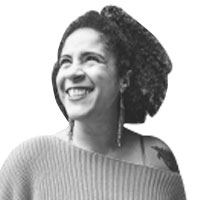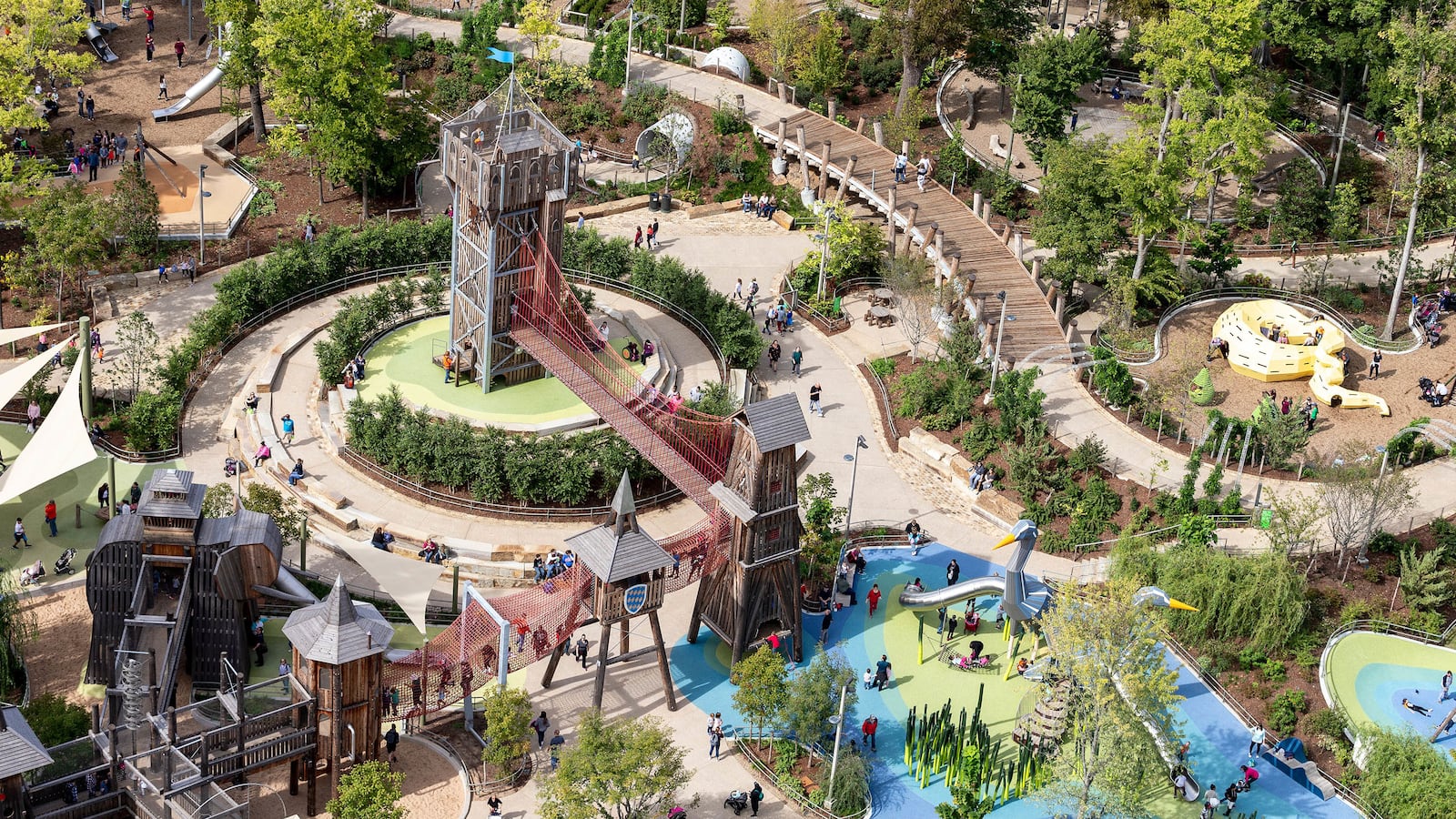Children and adults engaging their inner kid play chutes and ladders in a maze of wobbly nets, rickety rope bridges, and steep, twisty slides. Couples and groups of teens sit by the lake to watch canoes paddle by and take sunset selfies. Skateboarders glide past murals designed by local artists to test their skills along a riverfront course. It’s all contained within one of Tulsa, Oklahoma’s main attractions, the Gathering Place, a nearly 100-acre public park bordering the Arkansas River. It’s a big park with big goals: attracting tourists from around the country and uniting racially divided communities across the city.
Tulsa is grappling with its heavy past. It was the site of the Black Wall Street Massacre and simultaneous mass killings of Osage Nation peoples in 1921. Many street and building names still honor W. Tate Brady, the alleged founder of the city, who was a Klansman and instigator of the massacre. As part of this rebuilding and rebranding, Brady Street (which runs through downtown) has been renamed Reconciliation Way. Black Wall Street—the Greenwood District—is being revitalized with new restaurants, apartment buildings, and galleries honoring the area’s history. However, the pain of the past is still quite present as the city attempts to move forward.

The Gathering Place’s goal is to be intergenerational and intercultural, and to bring folks from all of Tulsa’s neighborhoods together in one space. The city is quite ethnically diverse yet geographically segregated: North Tulsa is predominantly African-American while South Tulsa is predominantly white. The Latino population is the fastest growing in the city, with many families living in East Tulsa, while Asian-American and immigrant populations from Korea, China, Vietnam, and Burma have their own micro communities around the city. The Native American Osage Nation has a long history in Tulsa and is a foundational part of the community. This segregation is no different from many other cities around the country but Tulsa’s violent history and commitment to reconciliation drives a desire for more connection across communities. The idea and hope is that play is a universal equalizer and unifier.
The waterfront park, which opened in September 2018, was designed by the internationally acclaimed architectural firm Michael Van Valkenburgh Associates (MVVA), known for their award-winning work with Brooklyn Bridge Park, Harvard Yard, and numerous other urban landscapes. Tulsa wanted to bridge the riverfront with the downtown area, which is only two miles away, to create a “nature-inspired” retreat within the city.
According to Tony Moore, the park’s executive director, the location was also chosen based on the Native American belief that water represents life and that villages have always been constructed around water. MVVA used natural materials that were cut down during construction to create playground structures, such as tree-trunk tripods for kids to sit under and logs as benches. Local stones were also incorporated by the architects throughout the park to connect it to “the region’s natural features.”
One of the park’s most impressive elements is its five-acre “Chapman Adventure Playground” with its ladders, suspended rope bridges, and zip lines that can handle babies and adults. Imagine Winterfell if it was wooden. Families can ride the “Slides of the Blue Herons,” metal spiraling slides designed to look like their avian namesakes. There’s a mini house of mirrors, sandboxes full of toddlers, and ample towers to climb. “Volcanoland” is a brightly colored padded play area for toddlers, while the “Ramble Sensory Garden” is designed to stimulate young people’s interest in STEM (science, technology, engineering, and mathematics). Also, it is certifiably Instagrammable.

That’s just a slice of what is available throughout this park. At the ONEOK Boathouse, visitors can rent kayaks, canoes, or paddleboats to cruise around “Peggy’s Pond,” while “Charlie’s Water Mountain” boasts shooting water jets, mist, and mini waterfalls to cool off during sweltering Tulsa summer days.
Folks can also live out their X Games dreams at a waterfront skate park designed to accommodate all levels, while other athletes have their pick of basketball, volleyball, or street hockey courts and soccer fields. With so many green spaces to relax, visitors can set up picnics (no barbecuing though!), or catch up with the mobile library to lounge in the grass and read. Visitors can walk or bike on trails along the Arkansas River, or meander through gardens featuring seasonal flowers and plants. It’s also brilliantly designed for logistics with 21 entrances and exits, as well as ample parking lots with free shuttles on the weekends. And you can spend a whole day there because there are cafes and restaurants, along with “grab and go” carts, all offering vegetarian and vegan options along with meals for carnivores.
Clearly, this is not your average urban park. Moore, who worked for 25 years in Orlando, the hub of American theme parks, explained that the Gathering Place was intentionally designed to create a theme park experience but in a free public park so that everyone can enjoy it regardless of income. Keeping it free and open is possible through a $465 million gift from the George Kaiser Family Foundation (GKFF) with support from additional donors. After seeing an exodus of talent leaving Tulsa ten years ago, GKFF has heavily invested in the city’s revitalization and retention of young people since that time.
Tulsa hopes the park can help shift Oklahoma from being a flyover state to an intentional destination, and there are signs that the city is getting its wish. In the eight months since it opened, The Gathering Place has attracted an influx of visitors from Texas, Kansas, and Arkansas, especially between Thanksgiving and spring break.
Moore notes that because there are no other free theme park-like attractions within a four-hour drive, the park is particularly attractive to vacationing families from neighboring states. Publicity, such as winning USA Today’s “Reader’s Choice Best New Attraction” award, along with word of mouth, have created a “halo effect” for people who might not otherwise think of visiting Tulsa or Oklahoma. And as coastal cities become more expensive and more saturated, the former “flyover” states and cities become more attractive refuges where your money goes further (tourism has become Oklahoma’s third largest industry).
Aside from the park’s clear tourist demographic, Moore emphasizes their focus on cultural programming to serve and unify the city’s diverse populations. During the planning stages, Moore and his team went to community centers, spoke with advocates, children, and organizers across ethnicities to try to understand what would bring people to the space. He wanted to know what make Tulsans “take pride” in the park and what would bring them back repeatedly. They’ve had free concerts featuring The Roots, A Tribe Called Red, and various popular Mexican bands. In 2019, they are planning the largest Native American festival in the Midwest (yes, Tulsa is considered the Midwest), “Celebrate Asia,” a cultural festival encouraging more interaction between Asian-American communities, and Latino food and music festivals. Additionally he shared that their commitment to ongoing cultural events and conversations is about sustainability beyond the strong opening season.
However, some activists and community members in Tulsa scoff at The Gathering Place’s mission to unite communities or serve as a catalyst for reconciliation. It is especially a sore spot for African-Americans who still deeply feel the effects of the 1921 Black Wall Street Massacre but also live far away from the park in a city with limited public transportation.

“People in my community see the Gathering Place as a beautiful park, that's it,” affirms Kristi Williams, also known as Orisabiyi, a mother of two and Co-Chair of the Greater Tulsa African American Affairs Commission. “My community is wondering why our rec centers have all been torn down and next on the chopping block is Ben Hill Park, named after a Tulsa legend.”
Tulsa is not unique in contending with the delicate balance between gentrification and community development but its distinctly painful history creates a tension that the city must grapple with.
“Reconciliation to me looks like giving land back to black people within the 40 blocks of Greenwood, zero interest business loans, grants, classifying Greenwood as a Historical District and landmark,” Williams offered. “Reconciliation means reparations. That is how this city will address the disparities… by destroying this very system that has supported oppression to black people here ’til this very day.”
Moore agrees that there is work to be done to fully acknowledge the impact of the 1921 Massacre. “If you don’t acknowledge the past, you risk making the same mistake twice. If this happened before, it can happen again, so let’s understand why it happened and how we can continue to move on and bring acknowledgement to what the Tulsan community has survived and achieved. It is by no means a ‘magic bullet,’ and the city’s narrative must go beyond the park, but it’s a start.”






